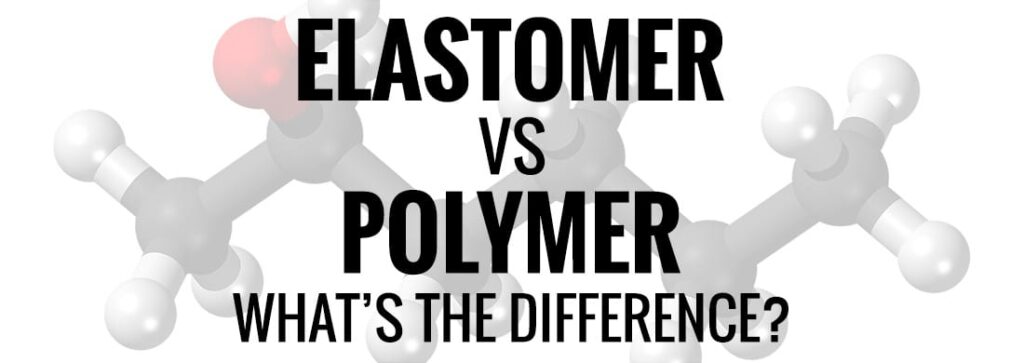Osborne Joins Farm Equipment Manufacturers Association
March 21, 2019What Are the Most Weather-Resistant Plastics?
April 17, 2019
The primary challenge in distinguishing an elastomer vs polymer is that elastomers are a subset of polymers. When you hear the word ‘elastomer,’ think ‘elastic,’ for the term is in fact derived from ‘elastic polymer.’ The elasticity of elastomers is a good reason why this particular polymer is often used interchangeably with the word, ‘rubber.’ Nevertheless, an elastomer is a polymer with viscoelasticity, having properties of both viscosity and elasticity. Below, we break down the primary differences between elastomer vs polymer.
What is an Elastomer?
An elastomer is made from polymers joined by chemical bonds with a slightly cross-linked structure. Without the cross-linkages, applied stress to an elastomer would result in permanent deformation. Because of it, the material is characterized by high elongation, flexibility, and elasticity. This helps prevent the material from cracking, snapping, or breaking when deformed.
What is a Polymer?
Polymer is a more general term for any molecule made of a long, repeating chain of smaller, bonding molecules called monomers. There are organic polymers such as amino acids and DNA, and more familiar synthetic polymers which include plastics like thermosets and thermoplastics. Synthetic polymers are used daily in products all around us: clothing and carpets are made from polyester fibers, foam cushions and upholstery in furniture are made of polymers, polyethylene cups, pipes and valves, plastic bags, medical devices, cookware, rubber for tires and tubing, paints, electronic components, adhesives, and so on, are all examples of polymers.
Elastomer Applications and Benefits
As a polymer, elastomers fall into a group of pliable polymeric, or plastic, material that includes artificial and natural rubber. They are good for molding, insulating, can withstand deformation and are formed easily into an assortment of rubbery shapes that are then hardened. Their versatility and usefulness make the application of elastomers popular in a wide variety of everyday products, from skateboard wheels and the soles of sneakers, to gaskets and electronic cabling and wire insulation.
Elastomer Properties
Elastomers can have properties similar to thermosets or thermoplastics. As a thermoset, they can be used in high-heat applications. The flexibility of a thermoset elastomer, like all thermosets, is limited to a degree with regard to reprocessing and recycling. Once a thermoset elastomer is created, it cannot be reversed. Thermoplastic elastomers, on the other hand, allow for reprocessing by heating the material above the glass transition temperature—that temperature which ‘transitions’ the material from hard and glassy to a soft, rubbery material. Thermoplastic elastomers are not well suited for high-heat applications.
Industries working with elastomers have long praised their beneficial properties:
Physical Versatility – One of the most obvious advantages of elastomers is their custom molding in size, shape, flexibility, and color to customer specifications.
Short Production Times – Elastomers can be mixed, molded, and cured or vulcanized rapidly, which makes for short production times.
Good Insulator – Its closed cell properties make for effective insulation of electronic and electrical products in a variety of home and industrial applications.
Excellent Adherence – Elastomers can easily be installed next to various other materials, such as metal, hard plastic, or different kinds of rubber, with excellent adherence.
Heat/Chemical/Creep Resistant – Elastomers do not melt, but pass into a gaseous state. Generally they are insoluble but will swell when exposed to certain solvents. They have lower creep resistance than thermoplastic materials. Some are even fire resistant which can add a measure of safety.
Environmental Durability – Thermosetting plastic elastomers remain stable at very high temperatures and resist harsh environments, and will keep their shape and colors, no matter the exposure to water or atmospheric gases. However, there is a need for more elastomers that perform at very low temperatures.
The Versatility of Elastomers
 Because of their flexibility and elasticity, the properties of elastomeric materials reflect its many uses. Besides natural rubber, elastomers are polymerized for such applications as the polyurethanes used in the textile industry, polybutadienes used for wheels or tires, neoprene used for wetsuits, wire insulation, industrial belts, and silicone, which is used in a wide range of materials—medical devices, molding, lubricants, etc.
Because of their flexibility and elasticity, the properties of elastomeric materials reflect its many uses. Besides natural rubber, elastomers are polymerized for such applications as the polyurethanes used in the textile industry, polybutadienes used for wheels or tires, neoprene used for wetsuits, wire insulation, industrial belts, and silicone, which is used in a wide range of materials—medical devices, molding, lubricants, etc.
The difference between elastomer vs polymer is that elastomers are a unique polymer with unique characteristics and properties. The applications are many, and are widely used across many industries, especially automobiles, sports, electronics, and assembly line factories.



